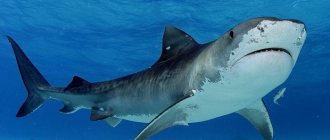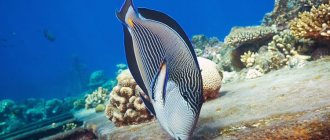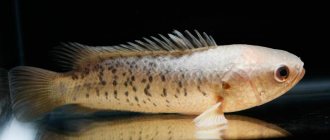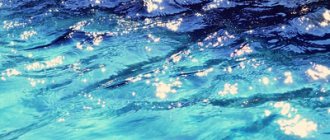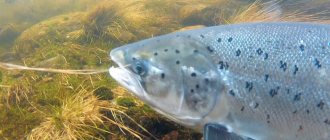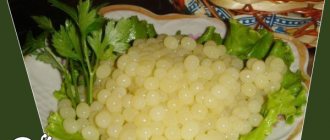White fish, pixabay.com Over the past five years, a reduction in the share of imports of fishery products and an increase in volumes and processing in the Russian Federation indicate a steady growth in fishing. This is in accordance with the Food Security Doctrine of our country.
At the same time, the fact that fish products are becoming less accessible to Russians is being hushed up. Over the past five years, fish in Russia has doubled in price. Consumers are forced to shift their interest from premium types of fish available. Cheaper fish does not mean that it is less tasty or healthy.
Sumatran barb
Sumatran barbs are small striped fish up to 6 cm in size. The body color is light golden with 4 vertical black stripes, the fins are red. Selection morphs have been developed: golden (the black color in the color is replaced by white) and mossy (the stripes merge with each other, due to which the body acquires an almost solid black-green color).
Sumatran barbs are hardy and unpretentious, suitable for a beginner’s aquarium. These fish are kept in a school of 6 or more at a temperature of 24-26°C, pH 6.5-7 and dH 5-18°. Barbs are extremely mobile and always remain visible in the aquarium.
Diseases and prevention
Proper care and maintenance of barbs allows you to grow healthy aquarium inhabitants that do not create problems. Frequent causes of the disease are weakened fish due to neglect of care rules. Considering barbs to be unpretentious fish, some aquarists do not understand that the fish is sick and requires treatment.
White-skinned
A common disease among barbels, which is introduced by new fish or plants.
How to determine:
- white skin appears next to the tail and dorsal fins;
- the color of the stripes becomes pale;
- the sick barb swims at the top so that the rays of the dorsal fin are visible;
- Appetite decreases, the fish becomes lethargic.
Treated with oxacillin solution, rinsing and disinfecting the aquarium.
Aeromonosis (rubella)
An infectious, common disease that affects barbs. The symptoms of aeromonosis are similar to dropsy. The infection occurs with new fish that have not undergone quarantine.
Obesity
If the fish are fed incorrectly, given more food than normal, they will begin to overeat and become obese. Visible signs of the disease: the body has become larger than normal, the fish has decreased motor activity and has become apathetic. To eliminate the disease, restoration of the correct diet is required. Do not feed the fish for the first 3 days.
Fin rot
Barbs begin to suffer from this disease due to the accumulation of dirt in the aquarium and if the water is cold.
Symptoms:
- the fins are surrounded by a light blue border;
- the length of the fins, which acquire an unnatural color, becomes shorter;
- loss of rays and clouding of the eyes occurs;
- rot destroys the fins, then spreads to the muscles and skin.
They are treated by replacing the water and raising its temperature to 28 degrees. Streptocide is added to the water.
Dropsy
The disease occurs rarely, only in unfavorable conditions. The fish's belly swells, the scales protrude, the anus protrudes, and the barbs become sluggish. Sometimes bulging eyes develop. Sick fish are destroyed, the aquarium with plants is treated with potassium permanganate, then filled with clean water.
Gill rot
A complex infectious disease affects the gills with blood vessels, causing them to rot and collapse. A sick fish's gills turn red, its appetite disappears, it rarely goes down and often hangs upside down. At the first stage, treatment is with rivanol and griseofulvin. In the acute stage, dark blue spots appear in those places on the gills where the tissue has begun to die.
Columnaria
Whitish formations similar to cotton wool, caused by bacteria, appear on affected areas. The development of the disease is slow.
Bloating
Common causes of bloating are: overfeeding, an inflamed gastrointestinal tract if dry food predominates, tumor or the appearance of tapeworms due to low-quality live food.
If the stomach swells slowly, this is obesity; if the problem is rapid, it is an infection.
Danio rerio
Danio rerio is a fish up to 6 cm long. The natural color is light golden with longitudinal dark blue stripes. Breeders have bred pink zebrafish (with bright pink stripes) and leopard zebrafish (the stripes are divided into small spots). In addition, zebrafish became the first genetically modified fish. By changing the genotype, fluorescent GloFish zebrafish were obtained. Their body color can be green, orange, yellow, pink, blue, purple or red with stripes.
Danio rerio are peaceful schooling fish. They are unpretentious and hardy; They feel best at a temperature of 17-25°C, pH 6.7-7 and dH 6-15°.
Reviews
Labidochromis yellow behaves differently: some successfully keep it with guppies and neons, while others show aggression towards their neighbors. Some aquarists keep yellowfish with American cichlids, but most agree that a tank with African species is the best and most aesthetically pleasing option.
Catfish platidoras
Platidoras striped is a catfish up to 24 cm long. It has an elongated body of sandy yellow color with wide longitudinal dark brown stripes. There are long whiskers on the head, and there are spikes on the fins. When excited and frightened, the catfish is capable of making fairly loud knocking and clicking sounds.
Platidoras is nocturnal. He spends most of his time during the day buried in the ground, and after turning off the light he goes out in search of food. These striped aquarium fish are kept singly or in groups at a temperature of 24-26°C, pH 5.8-7.5 and dH 2-20°. Platydoras are peaceful, omnivorous and easy to keep.
Feeding
Clowns are omnivorous fish; they happily eat:
- Artemia;
- dry food for reef fish;
- worms;
- caviar;
- seaweed;
- chopped shrimp;
- spirulina;
- octopus and squid meat;
- fish fillet.
Provide a varied diet. Feed your pets 2-3 times a day in small portions that they can eat in a couple of minutes. During the cleaning process of the sea anemone, the fish finds food in the tentacles of the invertebrate. Don't overfeed the clowns.
Leporinus striata
Leporinus striped is an unusual fish with a memorable appearance. Representatives of this species have an elongated body up to 30 cm long, yellow in color with vertical black stripes.
Leporinuses are kept at a temperature of 22-25°C, pH 5.5-7 and dH 10-12°. These fish do not tolerate even minor temperature fluctuations; changes in water parameters cause them stress and often result in death. In this regard, water changes are carried out no more than once a month, replacing no more than 20% of the volume. The aquarium must be equipped with shelters and plants. The leporinus diet should consist of 70% plant food and 30% animal food.
Gourami
“Sticking its mouth out of the water” is how the name of this fish is translated. She is originally from Southeast Asia. Belongs to the labyrinth group. Can exist in oxygen-poor water. The body is flattened laterally and elongated in length, which is 12-15 cm.
The female is distinguished from the male by its fins, which are more rounded and smaller in size. The pectoral fins look like threads and serve as organs of touch.
Gourami is very active and mobile, loves vegetation, prefers bright lighting. It is better to choose an aquarium volume of 60-70 liters. You can filter the water if you wish, but you must replace it by a third. And another must-have accessory is a lid for the aquarium, since gourami are excellent jumpers.
In peace and harmony, gourami share the water area with neons, angelfish, catfish, minors, and rasboras. Red parrots, all golden and viviparous fish are excluded from cohabitation.
Gourami love to eat good and varied food. Live foods are among the favorites. Cereals, cottage cheese, shredded cheese and meat - everything will do you good. In gouramis, males are larger in size than females.
There should be 3-4 females per male, otherwise the sexually active male simply drives one female.
Preparation for spawning includes moving out of the general aquarium, increased nutrition for the male and building a nest. Gourami eggs are covered with foam and float to the surface of the water, where they remain until the offspring appear.
The female’s function is considered completed at this point. Then the male takes care of the eggs and remains hungry all this time. At this time, it is very important to observe the temperature regime: if the thermometer readings drop below 24°C, the male immediately destroys the eggs.
The same thing can happen again at the fry stage - a hungry “father” can mistake his cubs for food. Therefore, it is important to resettle him in time. Food for the younger generation - daphnia, cyclops, ciliates.
Siamese algae eater
The Siamese algae eater is a fish up to 16 cm long. Representatives of the species have an elongated silver-colored body; along the sides there is a wide black stripe with jagged edges, extending onto the caudal fin.
Algae eaters are unpretentious and non-aggressive. They are kept at a temperature of 23-29°C, pH 5.5-8 and dH 5-20°. These striped fish are well suited for an aquarium overgrown with algae. Algae eaters eat lower algae, effectively cleaning plant leaves and decorations. At the same time, these fish do not touch higher plants. Algae eaters love to rest on the wide leaves of plants, so suitable species should be planted in the aquarium with them.
Neon
Another schooling fish. This bright and lively Peruvian got its name due to the similarity of its color to a neon advertisement. Half of her body is blue with a silver tint, her tail is red. Neon is a tetra.
These fish live in schools; they feel most comfortable in a group of 6-7 individuals.
Schooling fish are also called mollies, thorns, and clown loaches.
Neons have a peaceful character and their beauty is captivating. They live 2-4 years. But there are some requirements for the conditions of detention. The water should be soft, slightly acidic, but clean and fresh, the soil should be dark.
Water changes should be 25% every week. For this purpose, external and internal filters are used. Temperature 23-26°C - these fish love warm water. A separate advantage will be the dense planting of aquarium vegetation, which neons adore.
The only thing neons don't like is change. If the aquarium has recently been “put into operation” and has not yet been established, they should not be stocked yet. Neons are omnivores, but food needs to be selected small, since their small mouth cannot cope with large ones. Their favorite food is bloodworms and tubifex.
If there is a variety of food and comfortable conditions in the aquarium, then the neon will delight with its liveliness and brightness of color. These peace-loving beauties themselves will not hurt anyone, but they can suffer from aggressive individuals. You should not house them with a swordmouth or a cockerel.
Females are slightly larger than males. But their reproduction can cause certain difficulties. Initially, neon did not want to reproduce in artificial conditions. It only worked on the third try.
Breeders in France and the USA failed. The experiment was successful only in Germany - there was soft water suitable for them.
Important! There should be no filters in the aquarium for fry - if a small neon gets there, it will cost him his life.
To reproduce, neons need a separate aquarium, temperature - 25-26°C, water hardness - 1-2 dGH, pH - 4.0-6.0, darkening, moss on the bottom (spawn will be deposited on it).
When the eggs are laid, the parents are removed, the aquarium is removed to a completely dark place, since the sun's rays have a detrimental effect on the eggs. In a week the fry will swim on their own.
Cichlazoma striped
Cichlazoma striped is a cichlid up to 10 cm long. The color is bluish-gray with vertical black stripes. Contain cichlase at a temperature of 22-28°C, pH 7 and dH 5-18°. These fish are characterized by territorial behavior towards both members of their own species and other inhabitants of the aquarium. Therefore, they should be stocked in large volumes (from 100 liters per pair of fish, not counting neighbors of other species). In addition, it is necessary to place a sufficient number of shelters in the aquarium. Cichlazomas love to dig the soil, so the plants are planted in pots.
Fishing
The fishing for white fish has reached crazy proportions, but its population is recovering quite quickly. Thanks to this, there are no strict fishing restrictions, and the fish remains accessible to the general public.
Sea white fish are characterized by living at low temperatures in northern latitudes.
This is where the main fishing takes place. As a rule, caught individuals are processed directly at the catch site. They are instantly gutted and then blast frozen. This ensures maximum product quality. This is exactly the kind of fish you can buy at the Frost Fish store. Return to list
Angelfish
The angelfish is a popular striped aquarium fish. It has a laterally flattened body up to 15 cm long. The dorsal and anal fins are elongated and have the shape of a triangle; The height of the fish with fins reaches 25-30 cm. The natural color is silver with vertical black stripes. Breeders have bred white, black, marbled and blue angelfish, as well as genetically modified GLO angelfish, characterized by a fluorescent pink color without stripes.
Contain angelfish at temperatures above 24°C, pH 6.5-7.5 and dH 5-15°. These are peaceful, calm cichlids that do not dig the soil and do not spoil plants.
What benefits does regularly eating white fish bring to a person?
Eating white fish is a great way to improve your health:
- Valuable protein. Just 100 g of any white fish completely covers the daily protein requirement.
- A complete set of B vitamins allows the human body to cope with inflammatory reactions.
- The high content of vitamins and microelements is the key to strengthening nonspecific immunity.
- Due to the low amount of fat, white fish is an ideal choice for people watching their physical fitness or on a diet.
- Essential amino acids that cannot be synthesized by the human body. Without them, normal functioning and development of the muscular and cardiovascular systems is impossible, so these compounds are vital for people.
- The high content of iron and cyanocobalamin is the reason why fish is recommended to be consumed for the prevention and treatment of anemia.
- White fish fillets contain a lot of vitamin B2, which significantly reduces the risk of miscarriage during pregnancy.
- Finally, large amounts of vitamins A and E help people suffering from eye diseases stabilize their vision.
To this day, all the beneficial properties of white fish have not yet been studied!
Ternetia
Ternetia is a fish up to 5 cm in size. A distinctive feature of this species is its enlarged anal fin. Natural color is silver with 2 vertical black stripes in the front of the body; the back of the body is painted black. White thorns have been bred, as well as genetically modified GloFish thorns with fluorescent colors (green, blue, orange, yellow, red, pink and purple). These morphs have no stripes.
Ternetium is kept in a flock of 6 pieces at a temperature of 22-28°C, pH 6-7.5 and dH up to 20°. The aquarium should have good filtration, aeration and dim lighting, as well as thickets of living plants.
General information
Black Molly, or as it is called in English-speaking countries, Black Molly, is one of the selected forms of mollies. There is still debate among experts about which natural species gave rise to this beautiful breed.
Some believe that this is the sphenops molly (Poecilia sphenops), others put the latipinna molly (Poecilia latipinna) as the parent species. But for the average aquarist, this dispute is unlikely to have serious significance, because regardless of origin, the characteristics of keeping and reproduction of fish are absolutely identical.
It is worth noting that according to the modern classification, mollies belong to the genus Poecilia, but according to the established habit in our country, these fish are still called mollies.
Black Molly, despite her artificial origin, inherited amazing endurance from her ancestors. This fact, as well as the ease of reproduction (the fish give birth to ready-made fry), make mollies an excellent choice for beginning aquarists.
Zebra fish
Zebra fish is a marine fish up to 30 cm in size, distinguished by the bizarre shape of its body and fins. The head is large, the eyes are set high, the pectoral fins are enlarged and fan-shaped. The dorsal and pectoral fins are equipped with spines, to which the excretory ducts of the poisonous glands approach. The poison is dangerous for humans. The color is white with vertical red stripes of different widths; resembles the coloration of a zebra, which is how this striped fish got its name.
Zebra fish are kept at a temperature of 25-26°C and pH 8-8.4. The content of nitrogen compounds should tend to 0. Fish lead a sedentary lifestyle; feed on fish, shrimp and shellfish.
Compatibility
Intraspecific clashes are common, therefore, if you want to place several clowns in one aquarium, purchase a large tank and stock young amphiprions. Clowns are harmless to snails, crabs and corals, and are compatible with other marine life:
- Blennius;
- cardinal;
- butterfly fish;
- goby;
- chromis.
View this post on Instagram
#clownfish, #nemo, #clownocellaris, #amphiprionocellaris. From 800₽, shipping to the regions.
A post shared by Marine Aquariums (@aquareef116) on Oct 2, 2018 at 1:42am PDT
Keeping clown fish with predators and aggressive species is not allowed:
- acne;
- groupers;
- lionfish;
- balistes.
Heckel's discus
Heckel's discus is a fish up to 20 cm in size, characterized by a laterally compressed disc-shaped body. The color is bluish-yellow with multiple narrow longitudinal brown stripes. There are 3 vertical black stripes running through the head, tail and middle of the body. Between them are vertical pale brown stripes.
They contain discus fish at a temperature of 28-32°C, pH 4.2-6.2 and dH 1-5°. These are gentle and whimsical fish. They cannot tolerate sudden fluctuations in water parameters and are susceptible to stress, so any manipulations in the aquarium should be carried out carefully. Good aeration, filtration, dim lighting, plants and shelters are needed.
Zander
One of the most famous and valuable species of white fish is pike perch. It belongs to the perch family and lives in water bodies of the Earth’s Northern Hemisphere. Common pike perch is found in rivers and fresh lakes in Asia and Eastern Europe, while the Canadian and yellow species live in the United States and Canada. It is found mainly in fresh water bodies, but the marine species lives in the basin of the Black and Caspian Seas.
Pike perch is a large predatory fish. The length of its body can exceed a meter, and its weight usually reaches 10-20 kilograms. The main feature of pike perch is its fastidiousness. The fish is very sensitive to the purity of water and, at the slightest contamination, migrates to another body of water. Thanks to this, it practically does not accumulate harmful substances and has high nutritional qualities. In addition, pike perch meat has few bones, but is rich in protein, microelements and essential amino acids. It is recommended for strengthening the immune system, muscles, blood vessels and hair.
Viviparous carnivores
Swordtails
These are small fish that got their name because of their specific tail. There are black, orange, and combined colors. Swordtails are viviparous, so you can achieve offspring at home.
Guppy
Probably everyone has heard about such fish as guppies. They are small (up to 3 cm), easy to keep and not whimsical - that’s why they are loved. At the same time, they can be very spectacular; males have veil-shaped multi-colored tails. They are even more likely to produce offspring than mecheks.
Black mollies
There are black, orange, yellow, and also mixed breeds. In shape they are a cross between guppies and swordtails. The fish is larger than its relatives described above, so it requires aquariums of 40 liters or more.
Molliesia velifera
A fairly large subspecies of mollies - it can grow up to 15-16 centimeters. Based on this, choose the right size of your aquarium, as it must be at least 50 liters.
Pecilia
Pecilia are the personification of a whole genus - the Poeciliidae. They can come in a variety of colors, from bright orange to variegated with black splashes. Fish can grow up to 5-6 centimeters.
Characinaceae
Blue neon
A classic representative of neon. It has a red-blue color. These are one of the most spectacular fish, as they shimmer in the light, which is how they got their name. They can be kept in small aquariums of 10 liters or more. The fish is schooling, so it is better to have at least 4-5 individuals.
Red neon
The fish is very similar to neon blue, but in this case red is the predominant color. Fish must be kept in schools, so they are more comfortable, and you will have a more colorful presentation.
Black neon
Although the fish is less popular than its fellows, this does not make it look any less impressive. A school of such tiny fish can decorate any aquarium. We recommend keeping them in large herbal aquariums.
Tetra
Tetra fish love when there are a lot of living plants in the aquarium, and therefore oxygen. The body of the fish is slightly flattened, the predominant colors are red, black and silver.
Ternetia
Ternetia is also called the black tetra. The classic color is black and silver, with black vertical stripes. The fish is quite popular, so finding it in your city will not be difficult.
Black pacu
This fish stands out from other characins due to its size - in an aquarium it grows up to 40-50 centimeters. The pacu belongs to the piranha family, so it needs to select its neighbors very carefully.
Black betta cockerel
Wild bettas have black pigmentation, but other colors usually cover the black. The entire body is covered with black pigment, except for the caudal fin and belly area. Breeders have obtained several black varieties of cockerels, and here are just the most popular:
- Black Melano is the most popular of the black varieties. The fish are a dense dark black color, often blue-black (raven-wing color). To obtain offspring, this species is crossed with colored varieties, since the male and female black melano produce non-viable offspring.
- Black lace is a dark red fish, very rarely acquires a color like black melano.
- Black Orchid - dark black with streaks of steel blue in the fins, often forming an almost butterfly pattern; Black Devil - with red tints; Black ice - with shades of steel, royal or green.
- Copper-based black (newest trend) - unlike melano, the females of this variety are fertile.



